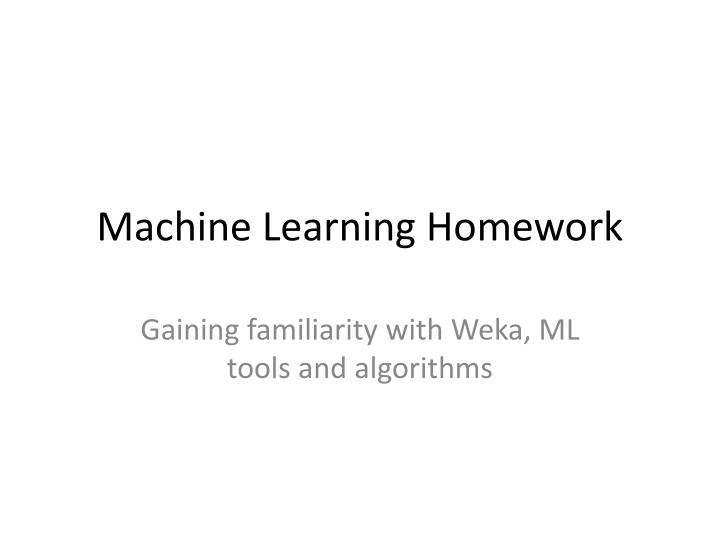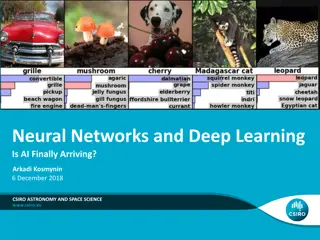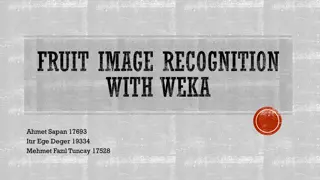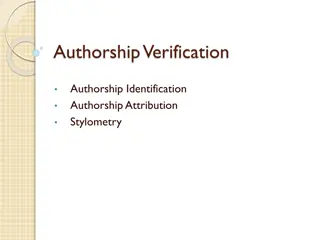
Machine Learning Homework: Weka, ML Tools & Algorithms
"Gain familiarity with Weka, machine learning tools, and algorithms through a structured homework that involves installing Weka, formatting data, and exploring datasets to identify predictive relationships."
Download Presentation

Please find below an Image/Link to download the presentation.
The content on the website is provided AS IS for your information and personal use only. It may not be sold, licensed, or shared on other websites without obtaining consent from the author. If you encounter any issues during the download, it is possible that the publisher has removed the file from their server.
You are allowed to download the files provided on this website for personal or commercial use, subject to the condition that they are used lawfully. All files are the property of their respective owners.
The content on the website is provided AS IS for your information and personal use only. It may not be sold, licensed, or shared on other websites without obtaining consent from the author.
E N D
Presentation Transcript
Machine Learning Homework Gaining familiarity with Weka, ML tools and algorithms
Goals 1. Learn how to use Weka, a collection of ML algorithms implemented in Java 2. Apply a few ML techniques to some standard datasets to see what happens
Step 1: Install Weka, get data Download and install Weka on some machine that you will be able to use for a while. Lab machines will not have this, but if you don t have access to another machine, let me know, and I will try to get this installed for you on a lab machine. http://www.cs.waikato.ac.nz/ml/weka/ Also, download a dataset. For this homework, I will ask you to use the University of California-Irvine s repository of machine learning datasets, and I will focus on this dataset: http://archive.ics.uci.edu/ml/datasets/Communities+and+Crime You can browse all of the datasets on UCI s machine learning repository here: http://archive.ics.uci.edu/ml/datasets.html You won t need these for this assignment, but you may be interested to see what datasets people have used in the past for ML research.
Step 2: Format the data For the Communities and Crime dataset, you should open the file communities.names and scroll down to the section that looks like: @relation crimepredict @attribute state numeric @data Copy this whole section, and paste it into the top of the file called communities.data . Rename the file communities.data to communities.arff . This puts the data into a format that Weka can easily understand.
Step 3: Load data into Weka Start Weka. You should see a menu like the one on the right. Click on Explorer . In the Preprocess tab, click on Open file. Find the communities.arff file that you created, and open it.
How it should look when you load the data into Weka:
First task: Get familiar with the data (and Weka) Click on the visualize tab. Use the scatterplots under this tab to try to get a feel for what this data contains. We will use ViolentCrimePerPop (total number of violent crimes per 100K popLuation) as the Y variable that we will try to predict in this dataset. What other variables seem to make a difference for predicting this variable, based on the plots you see? Question 1: Write down the name of three different features that you think each have a significant predictive relationship with ViolentCrimePerPop. For each one, briefly (1 sentence or less) describe the relationship.
Task 2: Determining relationships between variables Focus on the variables PctFam2Par (percentage of families (with kids) that are headed by two parents) and PctNotHSGrad (percentage of people 25 and over that are not high school graduates). Both seem to have some correlation with ViolentCrimesPerPop (total number of violent crimes per 100K popLuation). Question 2: Based on the plots in the visualize tab, see if you can determine whether there is a correlation between PctFam2Par and PctNotHSGrad or not. Explain what evidence you have found to support your conclusion.
Prepping for a regression First, you will need to remove non-numeric attributes from the data, since most of Weka s regression algorithms can t handle such attributes. Click on the preprocess tab. You should see a list of all 128 attributes (including ViolentCrimePerPop) on the left. Click the check box next to communityName . Click the button called remove at the bottom of the screen. You should be all set.
Task 3: Running a regression experiment You will see a list of many classifiers that are built in to Weka. Many of these are greyed-out, since they can t do regression. The non-grey ones are available for our experiment. Under functions , select linear regression . Under test options , select percentage split , and set the percentage to 66. Make sure that (Num) ViolentCrimePerPop shows up in the dropdown list below the test options. Click start . Click on the classify tab. At the top, click the button called choose . Question: When the classifier finishes, copy the results from the Classifier output box to a text file called linear-regression-results.txt .
Task 4: Running a more complicated regression model This time we ll try a Support Vector Machine. Click the choose box again, and under functions, select SMOreg . Use the same test options as before. Click start. (It may take 20-30 seconds to finish training.) Question: Which model performed better in this experiment? How can you tell? Cite two pieces of evidence that tell you why SMOreg was better than linear regression, or vice versa.
Task 5: Running a clustering experiment Click on the cluster tab at the top. Click the choose button, and select SimpleKMeans . To the right of the choose button is a textbox that says SimpleKMeans N 2 Click anywhere in the textbox. It should bring up a new window. In the new window, under numClusters , change it from 2 to 10. Click Ok . Set the cluster mode to use training set . Click start . When this finishes, in the Result-list text area, right-click the most recently- appeared line of text. Select Visualize cluster assignments from the popup menu. In the new window, change the X variable to Cluster (Nom) . Change the Y variable to ViolentCrimesPerPop (Num) . Question: Did the K-means clustering algorithm do a good job of separating the data into clusters that have different violent crime rates? What evidence from the chart you just created supports your conclusion? (2 sentences max.)









